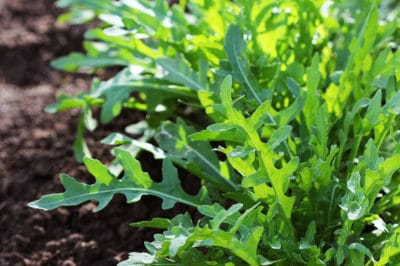What is Arugula?
Arugula (Eruca vesicara) is a green with a long history in Europe. Also known as rocket or rockette, the plant looks a bit like a big dandelion. Even the white flowers are edible, although their appearance usually signals that the leaves are too strong-flavored to eat. A cool-season plant, with protection it can be grown in winter in most climates. However, it dislikes summer heat.
Are There Different Varieties?
Arugula does come in different varieties. They vary in days to maturity as well as flavor.
- Runway – 21-40 days; very fast-growing.
- Garden – 30-40 days; has a zingy flavor much like radish.
- Italian Rocket – 46 days; sharp-flavored finely cut leaves.
- Astro II – 38 days; mild-tasting compared to other arugula varieties.
- Buckingham – 21-40 days; spicy flavor, but not hot.
When Should I Grow Arugula?
Arugula is best when planted in spring and fall or – with proper protection – in winter. Summer temperatures push the plant to bolt and flower. It throws up a tall flower stalk and goes to seed when temperatures warm up. In spring, you can plant as soon as temperatures are above 40°F (4°C). It grows best at temperatures between 60 and 65°F (15 and 18°C) and tolerates frost.
What Soil Does Arugula Need?
Like nearly all garden vegetables, arugula will grow best in fertile soil. It prefers a pH of 6-6.5. It also needs well-drained soil as it likes a lot of water but doesn’t like constantly wet feet. Since it can be planted in early spring, it’s best to prepare soil in fall with well-rotted leaves, aged manure and compost. You can also work in balanced 5-10-10 organic fertilizer.
How Do I Plant Arugula Seeds?
Arugula germinates best at soil temperatures between 40 and 65°F (4 and 18°C). You can broadcast seed or plant in rows, about ½ inch deep. Plant about one inch apart. Germination takes about seven to 14 days. Thin seedlings to six inches apart before they are three inches tall. Keep soil evenly moist. Arugula can be planted in the garden or containers.
How Do I Fertilize Arugula?
Proper soil preparation in the fall usually negates the need for additional fertilizer during the growing season. However, if it’s necessary, work a tablespoon of 5-10-10 organic fertilizer in the soil around each plant. You can also use foliar feeding or just water the plants with compost tea or a solution made from fish emulsion. Manure tea can add extra nitrogen.
Is Arugula a Good Companion Plant?
Companion planting is the practice of interplanting vegetables, herbs and flowers. This can benefit plants through promoting growth, reducing insects or attracting and feeding beneficial insect predators. Arugula grows well with bush beans, beets, carrots, dill, celery, lettuce and spinach, as well as cucumbers. It also likes nasturtiums and the herbs rosemary, thyme and mint, but not strawberries.
When Should I Harvest Arugula?
Arugula may be one of the fastest-growing of all vegetables; you can start harvesting within four weeks. Harvesting young assures the best flavor. You can even use thinnings from your rows. If you pick only the outermost leaves, the plant will continue to produce for weeks. Although you can still harvest once it begins to flower, the leaves will become much more pungent.
How Do I Store Arugula?
Ideally arugula should be harvested fresh and used immediately. The leaves are delicate and don’t hold up well. Wash the leaves and wrap them in a cloth or paper towel. Place them in a perforated plastic bag. Arugula stores best at 32 to 40°F (0 to 5°C) and 95 percent relative humidity. That’s actually a little cooler than the average refrigerator. It will taste best if used within three days.
How Do I Use Arugula?
Arugula is a natural for salads. It is nearly always included in mesclun mix. Most people prefer to add sweeter greens such as lettuce to balance the pungent sharpness of arugula. You can also add it to soups and pasta, or sprinkle it on pizza. Sauteed arugula makes a nice bed for some poached eggs. Finely chopped arugula can also be added to cooked grains like brown rice.
